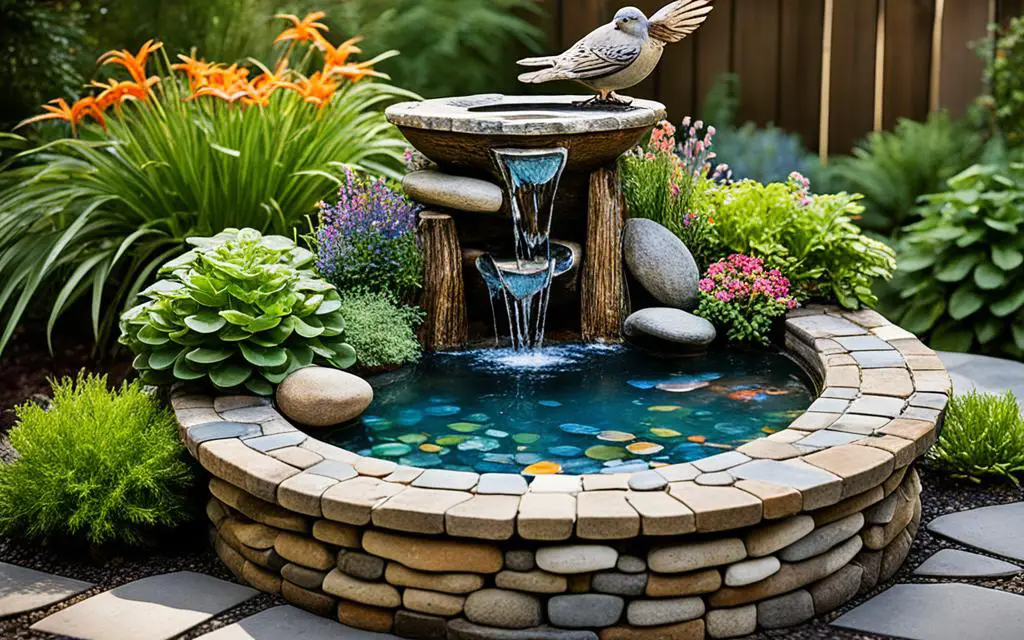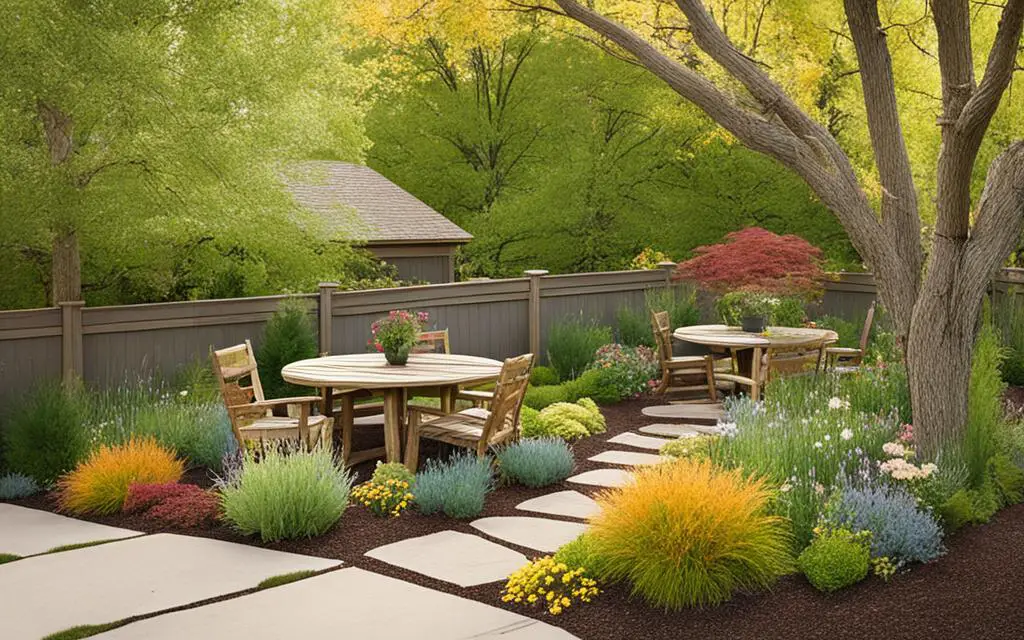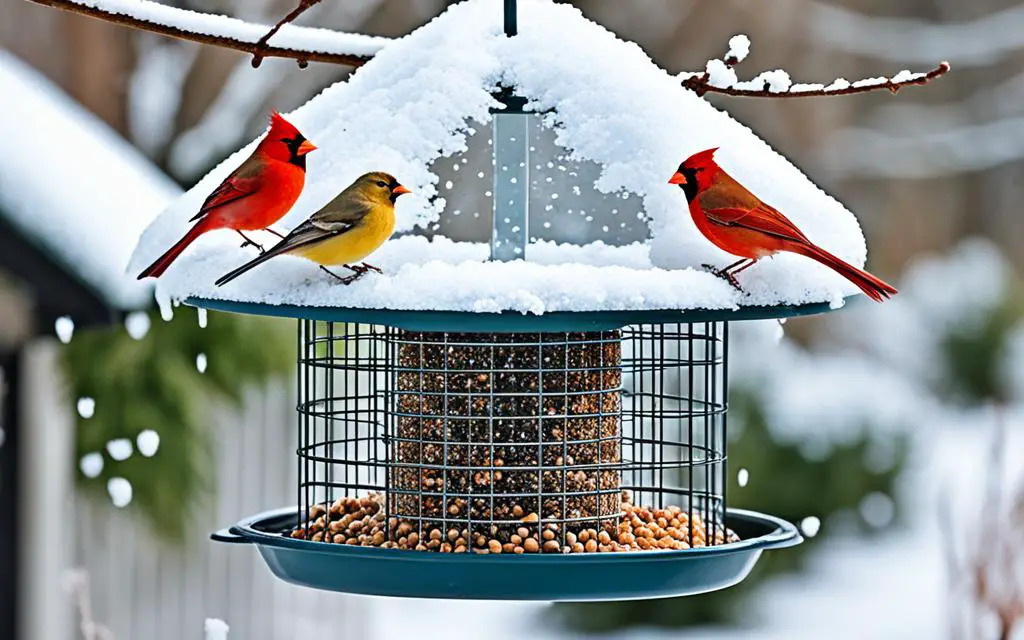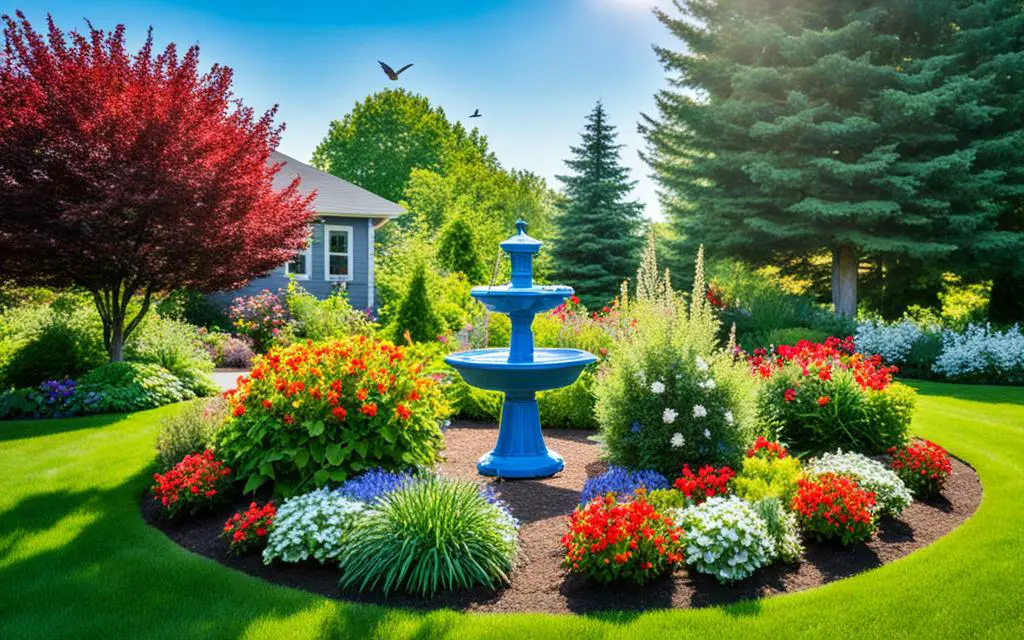Did you know North America lost nearly 3 billion birds between 1970 and 2019? This shocking loss signals a quiet crisis right in our yards. Yet, there’s hope. Your backyard can turn into a haven for birds. Birdscaping, or creating bird-friendly gardens, is more than a hobby. It’s a way to help save our feathered friends. By making your garden welcoming to birds, you do more than enjoy nature’s beauty. You fight against habitat loss and support diverse life.
Successful birdscaping means making your garden feel like a natural home for birds. You need the right mix of food, water, and shelter. This turns your yard into a sanctuary for many bird types. It also invites bees and butterflies. You’ll enjoy the sights and sounds that nature brings right to your door. By focusing on birds, you help balance nature that cities often disturb.
Key Takeaways
- Transformative birdscaping can help combat the dramatic bird population decline, making a true environmental impact from your yard.
- Understanding how to create a backyard bird sanctuary involves providing essential resources like food, water, and cover.
- Incorporating native plants in your garden sustains birds with natural food sources and cater to their habitat needs.
- A backyard bird paradise supports a larger ecosystem, attracting not just birds but other beneficial wildlife.
- Crafting a bird-friendly environment offers you a serene retreat and the joy of connecting with nature through birdwatching.
- Every small action toward birdscaping, such as installing a bird bath or planting a native shrub, has a substantial ecological ripple effect.
Integrating Native Plants into Your Backyard Bird Sanctuary
Using native plants is more than just a gardening trend. It’s a big step in making bird-friendly landscaping that turns your yard into a perfect home for birds. These plants offer natural food and places to nest for many bird types. This creates a lively ecosystem right behind your house. They are key for anyone deeply into landscaping for bird lovers.
Understanding the Appeal of Native Flora
Why are native plants so important? They grow naturally with local birds and animals, creating a balanced ecosystem. A yard full of native plants is like a welcoming light to birds, telling them they’ve found a safe place with plenty of food and shelter. These plants produce seeds, berries, and insects that birds need to survive. By planting them, you give birds food all year round in your own garden.
How to Source Native Plants for Your Region
Finding native plants is easy. You can go to a nearby nursery or use resources from groups like the National Audubon Society. They help you pick the right plants for your area. This careful choice means your yard will be good for birds and also easy for you to take care of.
Maximizing Biodiversity with Varied Plant Selection
To attract many different birds, mix up the plants in your garden. Use trees, shrubs, and flowers that bloom or produce fruit at various times. This way, birds always have natural food. This not only makes your garden look great but also supports a vibrant bird community.
| Plant Type | Benefits for Birds | Seasonal Interest |
|---|---|---|
| Flowering Plants | Attract insects for feeding; offer nectar | Spring/Summer |
| Shrubs & Bushes | Provide berries and shelter | Summer/Fall |
| Trees | Offer nuts, fruits, and nesting sites | All Seasons |
| Grasses & Groundcovers | Supply seeds and cover for ground-feeding birds | Late Summer/Fall |
By focusing on native plants, you do a lot for local birds. Your garden will be full of life, making you a key part of keeping the local environment diverse and healthy. You’ll enjoy watching a lively bird community in your yard.
Crafting a Water Oasis for Avian Visitors
As a fan of backyard birdscaping, you know a bird-friendly yard is about more than feed and plants. It’s a natural space that invites birds to rest and recover. Water is key for your garden for birds. It’s where they can drink, bathe, and preen, which keeps them healthy.
Add a water feature to attract different birds, like a natural water spot would. Even a simple dish or an elaborate setup can turn your yard into a bird paradise. Birds like baths that are gently sloped and textured. This makes it easy for them to get in and feel secure. The right depth depends on the birds you want to attract.
Keeping your water feature clean is important to keep the birds healthy. Change the water and clean the bath often. This stops algae from growing and diseases from spreading. Here is a quick guide to help you with your water features:
| Feature | Benefits | Maintenance Tips |
|---|---|---|
| Bird Baths | Accessible hydration and bathing station | Refill and clean several times a week |
| Ponds | Supports a wider variety of wildlife | Use natural plants to help keep the water clean |
| Waterfalls | Mimics natural environments with running water | Check for free-flowing water to prevent stagnancy |
Think about where to place your water feature. It should be close to a hose for easy refills and in a shaded spot to reduce evaporation. It’s good to have it near some protective cover. But keep it away from thick bushes where predators might hide. With careful planning, a water feature can be the highlight of your bird-friendly yard.

Creating the perfect water oasis takes some work, but it’s worth it. The joy of watching birds play and splash around is priceless. By following these tips, your garden for birds will be more than just alive. It will be a thriving, refreshing home for many colorful birds.
Designing Natural Shelters and Nesting Sites
In the world of birdscaping, it’s key to make your yard inviting for birds. You’ve got to offer them places to shelter and nest. Turning your garden into a birdwatching haven means they get food and safety. This way, birds can thrive right outside your home.

Natural shelters like big trees and thick bushes give birds a break spot. They also find food and hide from bad weather. Putting birdhouses and boxes around your garden draws birds in. Keeping these homes clean and fixed up is a must. This way, birds will want to stay.
Check out this table of shelter suggestions for different birds. Giving them varied shelter types shows you care about all bird kinds. This makes your yard perfect for many birds.
| Shelter Type | Description | Benefits |
|---|---|---|
| Evergreen Trees | Year-round protection and shelter | Privacy, warmth during winter, and a safe breeding space |
| Shrubs and Bushes | Dense foliage near the ground | Protection from predators, nesting, and foraging opportunities |
| Roosting Boxes | Enclosed structures with entrance holes | Refuge during harsh weather and a place to raise young |
| Birdhouses | Specifically designed nesting boxes | Attract specific bird species and support their nesting habits |
By using these tips, you’ll draw various birds to your place. This effort helps the environment and makes a rich bird area. The happiness from seeing birds thrive in your space is unmatched. Start your bird-friendly landscaping now and enjoy the beauty it adds to your yard.
Backyard Birdscaping: Seasonal Strategies for Sustenance and Shelter
Creating a backyard bird sanctuary means meeting the needs of birds as the seasons change. When you attract birds to your yard, switching from spring nectar to winter suet is key. This makes your landscaping efforts successful. Let’s find out how to make birds feel welcome in your backyard throughout the year.
Year-Round Food Offerings: From Nectar to Suet
It’s important to give birds a variety of foods. In winter, offer suet, peanuts, and seeds high in protein to keep birds energized. As warmer weather returns, serve fruits and nectar. This is perfect for migrating birds and those that nest in the spring.
Adapting Your Bird-Friendly Practices with the Changing Seasons
Along with food, making sure birds have access to clean water is essential. This is especially true when natural water sources are hard to find. In cold areas, a heated birdbath can offer birds water all year long. Keeping feeders and birdbaths clean helps your bird sanctuary stay healthy and pest-free.

| Season | Food Source | Suggested Setting |
|---|---|---|
| Winter | Suet, Peanuts, High-fat seeds | Weather-protected feeders |
| Spring | Nectar, Fruits, Insect-attracting plants | Garden beds and feeders near blooming plants |
| Summer | Insects, Berries, Small fruits | Sheltered feeders and fruit-bearing shrubs |
| Fall | Seed mixes, Grains, Nuts | Open feeders and ground feeding areas |
Using these seasonal strategies will make your bird-friendly landscaping a success. Your backyard will become a bustling bird sanctuary. It will be filled with joy and life throughout the year.
Conclusion
By now, you know that making your backyard friendly to birds is more than gardening. It’s a step towards helping our feathered friends. By adding native plants, water features, and cozy shelters, you make your garden a paradise for birds. This way, you do more than attract birds; you create a safe place for them all year.
Your efforts in creating a bird-friendly yard are clearly seen by the birds that visit. Every plant and birdbath in your garden adds to a lively world. By following the advice in this guide, you make a beautiful sanctuary for birds. This also helps bird populations and their ecosystems.
The journey to a bird-friendly garden is full of learning and discovery. As you work on your garden, you join others who love birds as much as you do. Here’s to the happy times in your garden, filled with bird songs. It shows how nature and your outdoor space can live in harmony.
FAQ
What Is Backyard Birdscaping and Why Should I Consider It?
How Do Native Plants Benefit Birds in My Yard?
Where Can I Find Native Plants Suitable for My Region?
What Should I Consider When Adding a Water Feature in My Yard?
What Types of Shelters Can I Provide for Birds in My Garden?
How Can I Ensure a Consistent Food Supply for Birds Year-Round?
What Seasonal Strategies Should I Employ to Maximize My Yard’s Appeal to Birds?
Are There Any Special Considerations for Creating Bird-Friendly Habitats in Urban Areas?

My name is Shane Warren, the author behind Your Bird Buddy – your ultimate guide to the wonderful world of birds! Unleash your inner avian explorer as we delve into a vibrant library of knowledge dedicated to all things feathered. From learning about diverse bird species from across the globe to understanding their captivating habitats and behaviors, I’m here to fuel your passion for these magnificent creatures. Not only that, but I also provide valuable insights on being a responsible and informed pet bird owner. Join our vibrant community and let’s celebrate the feathered wonders of the world together – one chirp at a time. And be sure to join our Your Bird Buddy Community over on Facebook!


Comments are closed